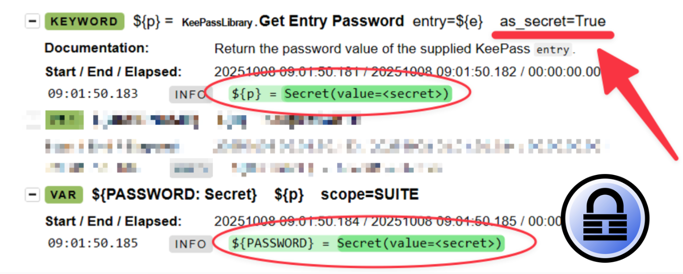Game Changer: Secret Variables!
Security by Design

If you work with sensitive data in Robot Framework, you know the dilemma: Suddenly, a password, token, or API key slips into the log and is visible to everyone… 😬 The reason: Robot Framework logs everything: every variable, every keyword call, every return value.
This is cool for debugging. But it’s fatal when you’re working with real access data. A new feature in Robot Framework promises to remedy this—and this article explains exactly how.
Workarounds everywhere – but no real solution
Here is a small ‘best of workarounds’ to prevent the logging of sensitive data:
- Use a listener (e.g. RobotLogListener from Robocorp):
The keywordRegister Protected Keywordsis fed with a series of keywords, which are then intercepted by the listener during execution.
This works, but you should meticulously go through your test beforehand and identify the relevant keywords. - Patch or overwrite keywords. You can do this, but it’s quite a mess.
- Run
sedfilters on the log files after the test execution to remove sensitive data. Also seen this before, but it’s also a bit of a mess. - Change the log level so that the message disappears. Not useful because the data may still be in the XML log.
Conclusion: All of these approaches treat symptoms, not the cause.
Robot Framework 7.4: Secret Variables
RF 7.4 introduces a feature that you should definitely learn about:
👉 Secret Variables.
The official release note describes it as follows:
“The most important enhancement in Robot Framework 7.4 is the support for “secret” variables that hide their values in data and log files. These variables encapsulate their values so that the real values are not logged even at the trace level when variables are passed between keywords as arguments and return values.”
What does this mean?
Once a variable is declared as secret, its value is hidden by Robot Framework.
It is then no longer visible in the log, even at the most detailed level (TRACE).
And best of all, it’s a no-brainer that doesn’t require you to rely on external tools or scripts.
How it works
There are a few things you should keep in mind when using secrets.
(I am using examples from the release notes):
How is a secret created?
Secrets can be created in three ways:
As a command line argument:
robot --variable "PASSWORD: Secret:topsecret"
For comparison, here is a “normal” variable:
robot --variable "PASSWORD: topsecret"
💡 Note: The secret is simply preceded by Secret:.
In a variable definition
The definition of secrets in the variable section works syntactically almost the same as with the VAR statement, as the two examples show:
*** Variables ***
${NORMAL: Secret} foo ❌ #1
${NORMAL: Secret} ${XXX} #2
${ENVIRON: Secret} %{EXAMPLE} #3
${DEFAULT: Secret} %{=robot123} #4
${JOIN: Secret} ${XXX}-123 #5
*** Test Cases ***
Test Example
VAR ${NORMAL: Secret} foo ❌ #1
VAR ${NORMAL: Secret} ${XXX} #2
VAR ${ENVIRON: Secret} %{EXAMPLE} #3
VAR ${DEFAULT: Secret} %{=robot123} #4
VAR ${JOIN: Secret} ${XXX}-123 #5
It is important to know which assignments are allowed - and why the first assignment of “foo” (a string literal) fails.
Let’s take a step back: the purpose of secret variables is to protect sensitive data from being exposed in logs and test code.
👉 So if “foo” is really a secret, then you would have already revealed it by using it here in plain text. 😉
Therefore:
- ❌ Assignments of literals (plain text values) are not permitted.
- The value of a secret (e.g.
${XXX}) must be of type Secret. - An environment variable can be assigned directly because it is set outside the test code. (Of course, access to the test host must be protected…!)
- A fallback value for an unset environment variable is also a correct secret assignment.
- The combination of a secret variable with a literal is also possible.
Mnemonic: Secret values are those that can be controlled externally instead of being hard-coded.
Programmatic secret generation with Python
Python-based variable files are a powerful tool – they allow you to define variables programmatically before the suite starts – and dynamically, if necessary.
In a Python varfile, you only need to import the Secret type class – and you can then define variables of the type “Secret”:
from robot.api.types import Secret
USERNAME = "robot"
PASSWORD = Secret("robot123")
⚠️ Of course, such a varfile should not be committed to a repository – therefore, add it to the .gitignore file.
The second Python-based method involves Python functions that return secrets as keywords:
from robot.api.types import Secret
def get_token(token_plain):
return Secret(token_plain)
This is where the real potential lies for libraries whose keywords return sensitive data.
How do I access secrets?
The plaintext value of a secret is stored in the .value attribute.
Example: the first log statement does not reveal the secret.
In the second, you can see that you access the “value” attribute using “dot notation”:

But be careful, the .value attribute should really only be used for testing or debugging purposes – if you use it in robot code, you run the risk of leaking the secret into the log file!
Ideally, the keywords should only pass secrets back and forth – the .value should only be accessed in the Python code below.
A practical example: KeePass meets Robot Framework
Finally, I would like to show how I tried out and used the new feature directly in a customer project.
A robot test for a web-based ticket system obtains its access data from KeePass.
Unfortunately, the KeePassLibrary currently returns the password in plain text, which inevitably ends up in the log:

I have therefore extended the library so that it optionally returns the return value of the keyword Get Entry Password as a secret object (only if Robot Framework is version 7.4 or higher, of course) .

I hope the pull request will be integrated soon so that everyone can benefit from the new feature.
Conclusion: A small step with a big impact
One thing we should note: Secret variables are not a “security feature” in the traditional sense.
This is not about encryption, but about concealment.
However, they close a crucial gap between convenience and data protection.
You can now write tests that use sensitive data natively, so to speak, without leaving risky traces in the log.
Question for you: How do you currently handle confidential data in your Robot Framework tests? Write your answer in the comments below!

